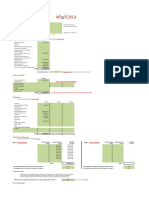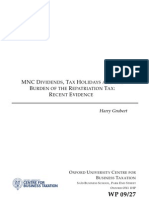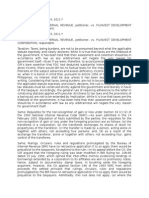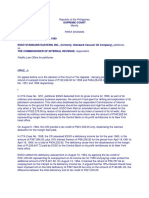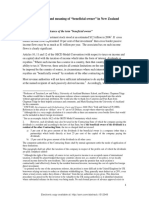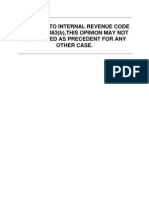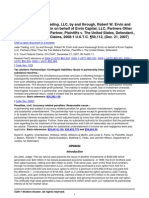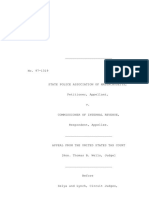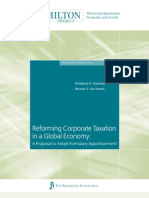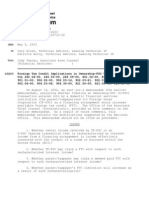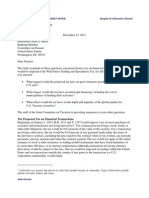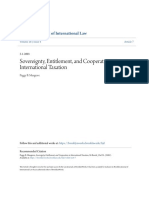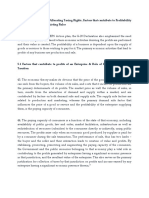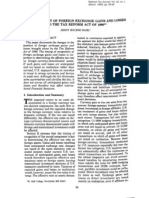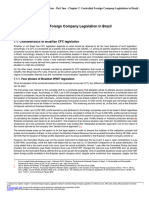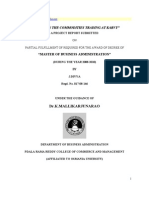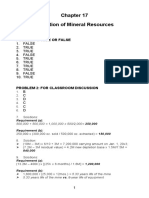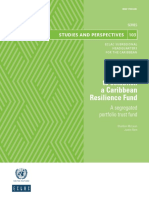0 ratings0% found this document useful (0 votes)
39 viewsThe Difficulties With The Subpart F System of International Taxation: How The Schering-Unclear and Unwise
The Difficulties With The Subpart F System of International Taxation: How The Schering-Unclear and Unwise
Uploaded by
David S ChenComplicated subpart F rules govern the taxation of transactions between a
U.S. parent company and its foreign subsidiaries. The difficulty with
interpreting the subpart F rules and applying them to complex derivative
transactions has been the subject of extensive tax literature. Few of the
proposed solutions have been simple enough to implement quickly and
efficiently without wholesale changes to the subpart F system. This Comment
focuses on the inconsistent tax treatment of economically equivalent
transactions that currently exists under subpart F and the incentives that this
system creates for U.S. companies to engage in expensive tax-planning
strategies to avoid subpart F taxation. These tax-planning strategies—used to
achieve an economically identical result—cost both the government and U.S.
companies unnecessary money.
Copyright:
© All Rights Reserved
Available Formats
Download as PDF, TXT or read online from Scribd
The Difficulties With The Subpart F System of International Taxation: How The Schering-Unclear and Unwise
The Difficulties With The Subpart F System of International Taxation: How The Schering-Unclear and Unwise
Uploaded by
David S Chen0 ratings0% found this document useful (0 votes)
39 views33 pagesComplicated subpart F rules govern the taxation of transactions between a
U.S. parent company and its foreign subsidiaries. The difficulty with
interpreting the subpart F rules and applying them to complex derivative
transactions has been the subject of extensive tax literature. Few of the
proposed solutions have been simple enough to implement quickly and
efficiently without wholesale changes to the subpart F system. This Comment
focuses on the inconsistent tax treatment of economically equivalent
transactions that currently exists under subpart F and the incentives that this
system creates for U.S. companies to engage in expensive tax-planning
strategies to avoid subpart F taxation. These tax-planning strategies—used to
achieve an economically identical result—cost both the government and U.S.
companies unnecessary money.
Original Title
THE DIFFICULTIES WITH THE SUBPART F SYSTEM OF INTERNATIONAL TAXATION: HOW THE SCHERING-PLOUGH DECISION INDICATES THAT THE STATUS QUO IS UNCLEAR AND UNWISE
Copyright
© © All Rights Reserved
Available Formats
PDF, TXT or read online from Scribd
Share this document
Did you find this document useful?
Is this content inappropriate?
Complicated subpart F rules govern the taxation of transactions between a
U.S. parent company and its foreign subsidiaries. The difficulty with
interpreting the subpart F rules and applying them to complex derivative
transactions has been the subject of extensive tax literature. Few of the
proposed solutions have been simple enough to implement quickly and
efficiently without wholesale changes to the subpart F system. This Comment
focuses on the inconsistent tax treatment of economically equivalent
transactions that currently exists under subpart F and the incentives that this
system creates for U.S. companies to engage in expensive tax-planning
strategies to avoid subpart F taxation. These tax-planning strategies—used to
achieve an economically identical result—cost both the government and U.S.
companies unnecessary money.
Copyright:
© All Rights Reserved
Available Formats
Download as PDF, TXT or read online from Scribd
Download as pdf or txt
0 ratings0% found this document useful (0 votes)
39 views33 pagesThe Difficulties With The Subpart F System of International Taxation: How The Schering-Unclear and Unwise
The Difficulties With The Subpart F System of International Taxation: How The Schering-Unclear and Unwise
Uploaded by
David S ChenComplicated subpart F rules govern the taxation of transactions between a
U.S. parent company and its foreign subsidiaries. The difficulty with
interpreting the subpart F rules and applying them to complex derivative
transactions has been the subject of extensive tax literature. Few of the
proposed solutions have been simple enough to implement quickly and
efficiently without wholesale changes to the subpart F system. This Comment
focuses on the inconsistent tax treatment of economically equivalent
transactions that currently exists under subpart F and the incentives that this
system creates for U.S. companies to engage in expensive tax-planning
strategies to avoid subpart F taxation. These tax-planning strategies—used to
achieve an economically identical result—cost both the government and U.S.
companies unnecessary money.
Copyright:
© All Rights Reserved
Available Formats
Download as PDF, TXT or read online from Scribd
Download as pdf or txt
You are on page 1of 33
SOLEIMANI GALLEYSFINAL 2/15/2011 2:28 PM
THE DIFFICULTIES WITH THE SUBPART F SYSTEM OF
INTERNATIONAL TAXATION: HOW THE SCHERING-
PLOUGH DECISION INDICATES THAT THE STATUS QUO IS
UNCLEAR AND UNWISE
ABSTRACT
Complicated subpart F rules govern the taxation of transactions between a
U.S. parent company and its foreign subsidiaries. The difficulty with
interpreting the subpart F rules and applying them to complex derivative
transactions has been the subject of extensive tax literature. Few of the
proposed solutions have been simple enough to implement quickly and
efficiently without wholesale changes to the subpart F system. This Comment
focuses on the inconsistent tax treatment of economically equivalent
transactions that currently exists under subpart F and the incentives that this
system creates for U.S. companies to engage in expensive tax-planning
strategies to avoid subpart F taxation. These tax-planning strategiesused to
achieve an economically identical resultcost both the government and U.S.
companies unnecessary money.
This Comment uses the Schering-Plough Corp. v. United States decision to
highlight the difficulties in properly complying with subpart F and the lengths
to which a taxpayer must go to avoid subpart F. It explores the reasons why
the subpart F system was created the way that it was, as well as the competing
theories on international taxation that led to the subpart F system. This
Comment then proposes that economically equivalent transactions should be
taxed the same, either by using the transfer pricing rulescurrently used to
govern asset sales between a parent and its foreign subsidiarymore
extensively in governing cash loans and loans of property between a parent
and its foreign subsidiary, or alternatively, by treating asset sales between a
foreign subsidiary and its domestic parent as a repatriating eventthe same
way that a loan between a foreign subsidiary and its domestic parent is
currently treatedand taxing the entire transaction under subpart F. Either
option would give greater consistency to transactions governed by subpart F
and would be relatively simple to implement within the political process.
SOLEIMANI GALLEYSFINAL 2/15/2011 2:28 PM
504 EMORY LAW JOURNAL [Vol. 60
INTRODUCTION .............................................................................................. 505
I. THE SCHERING-PLOUGH CASE ............................................................ 507
II. THE HISTORY AND ENACTMENT OF SUBPART F ................................. 512
A. How Subpart F Became the Law ................................................ 512
B. The Current Subpart F Rules ..................................................... 514
III. THE DIFFERENCE BETWEEN AN INTERNATIONAL TAX SYSTEM
BASED ON CAPITAL IMPORT NEUTRALITY AND ONE BASED ON
CAPITAL EXPORT NEUTRALITY .......................................................... 518
IV. DIFFICULTIES AND PROPOSED SOLUTIONS TO THE CURRENT
SUBPART F SYSTEM ............................................................................ 521
A. The Debate over the Treatment of Hybrid Entities Under
Subpart F .................................................................................... 521
B. Proposed Academic Solutions to Subpart F ............................... 523
1. Benefits and Drawbacks of Implementing Uncontrolled
CEN ...................................................................................... 523
2. Benefits and Drawbacks of Implementing Uncontrolled
CIN ....................................................................................... 525
V. POSSIBLE REMEDIES TO THE ARBITRARY CLASSIFICATION OF
ASSETS BY THE COURT IN THE SCHERING-PLOUGH DECISION ............ 527
A. The Schering-Plough Transaction: Was It a Sale or a Loan?
Why We Need a Better Way to Tell the Difference ..................... 528
B. Using Theories of Global Taxation to Remedy the Arbitrary
Categorizations of Income Taxed by Subpart F ......................... 530
VI. PROPOSED CHANGES TO SUBPART F: TAXING ECONOMICALLY
IDENTICAL TRANSACTIONS THE SAME ............................................... 531
A. First Proposal ............................................................................. 532
B. Second Proposal ......................................................................... 533
CONCLUSION .................................................................................................. 534
SOLEIMANI GALLEYSFINAL 2/15/2011 2:28 PM
2010] SUBPART F SYSTEM OF INTERNATIONAL TAXATION 505
INTRODUCTION
Permitting a taxpayer to control the economic destiny of a
transaction with labels would . . . exalt form over substance, thereby
perverting the intention of the tax code.
1
Currently, under subpart F of the Internal Revenue Code,
2
most forms of
income earned by a foreign subsidiary of a domestic company
3
are not taxed
until the income is repatriated
4
to the United States. Once the income is
repatriated to the domestic parent, the amount of money that has been earned
abroad is then usually subject to subpart F taxation. Subpart F provides
detailed rules and regulations describing when income earned by a foreign
subsidiary is subject to U.S. taxation.
5
In 1991, the multinational drug corporation Schering-Plough was faced
with a ballooning balance sheet as its cash reserves and debt were rising to
high levels.
6
Schering-Ploughs cash was tied up in its foreign Irish and Swiss
subsidiaries, while its domestic parent accumulated the debt.
7
Schering-Plough
wanted to get the cash from its foreign subsidiaries to pay down its domestic
debt and slow the ballooning of its balance sheet, but also wanted to avoid the
significant subpart F taxation that would accompany the simple transfer of
these funds from foreign subsidiary to parent.
8
In an effort to avoid subpart F taxation while still getting lump sum
payments from its subsidiaries, Schering-Plough enlisted the help of Merrill
Lynch to design a transfer method with the sole goal of deferring taxation.
9
The transfer method consisted of two waves of contracts, the first in 1991 and
the second in 1992.
10
Each wave was essentially the same: notional principal
contracts
11
based on a large amount of money that would provide Schering-
1
Schering-Plough Corp. v. United States, 651 F. Supp. 2d 219, 242 (D.N.J. 2009).
2
I.R.C. 951965 (2006).
3
This income is generally referred to as active income. See, e.g., Stephen E. Shay, Exploring
Alternatives to Subpart F, TAXES, Mar. 2004, at 29, 30.
4
Repatriation is the transfer of income earned in a foreign country back into the home country, which
for the purposes of this Comment will be the United States.
5
See generally I.R.C. 951965.
6
Schering-Plough Corp., 651 F. Supp. 2d at 226.
7
Id. at 22526.
8
Id. at 22728.
9
Id. at 226. Schering-Plough paid Merrill Lynch $2.2 million for its services in connection with the
1991 swap and $2 million for its work on the 1992 swap. Id. at 23032.
10
Id. at 22932.
11
See infra notes 2425 and accompanying text.
SOLEIMANI GALLEYSFINAL 2/15/2011 2:28 PM
506 EMORY LAW JOURNAL [Vol. 60
Plough with a right to receive a stream of income over twenty years.
12
Schering-Plough then sold this interest in income to one of its subsidiaries.
13
That way, Schering-Plough hoped to amortize the lump sum from the
subsidiary over the lifetime of the contract, rather than paying taxes on the
lump sum all at once.
14
The Internal Revenue Service (IRS) challenged this arrangement, claiming
that the transactions were actually loans between Schering-Plough and its
foreign subsidiaries.
15
The U.S. District Court of New Jersey agreed with the
IRS and held that the transactions were loans, which subjected Schering-
Plough to a $473 million tax liability.
16
The courts analysis in recategorizing
the notional principal contracts as loans was extremely complex and detailed,
and it is unclear which factors the court used to determine whether the
transaction was a loan. The courts analysis highlights the difficulties that
exist with the current subpart F system, and the loopholes and tax-planning
strategies available as a result of these rules.
17
To fully appreciate the issues in Schering-Plough, an analysis of the two
competing theories on international taxation, Capital Import Neutrality (CIN)
and Capital Export Neutrality (CEN), is necessary. CIN is an international tax
system predicated on the assumption that all businesses in the same country
should be taxed at the same rate.
18
If all countries had identical rates of
taxation for income earned within their borders, then CIN would be achieved.
19
On the other hand, CEN is achieved when a country taxes only its residents on
their worldwide income.
20
Moving toward a system of CEN lessens the
problem of categorizing a specific asset for tax purposes because wherever a
taxpayer chooses to do business, it would be taxed at the same rate.
21
CEN
would eliminate the role that taxes play on where an investor does business and
would make efficiency the driving force behind investment.
22
12
Schering-Plough Corp., 651 F. Supp. 2d at 222.
13
Id.
14
Id.
15
Id. at 234.
16
Id. at 221, 272.
17
See infra note 109 and accompanying text.
18
See infra note 123 and accompanying text.
19
See infra note 123 and accompanying text.
20
Tsilly Dagan, National Interests in the International Tax Game, 18 VA. TAX REV. 363, 367 (1998).
21
See infra note 115 and accompanying text.
22
See infra note 121 and accompanying text.
SOLEIMANI GALLEYSFINAL 2/15/2011 2:28 PM
2010] SUBPART F SYSTEM OF INTERNATIONAL TAXATION 507
Additionally, to repair the difficulties with subpart F it is important that
transactions between a domestic parent and a foreign subsidiary should be
treated consistently. There is no reason that the sale of an asset between a
parent and its subsidiary should not trigger subpart F income while a loan
between the two does. Consistent treatment of these transactions can be
achieved by using the transfer pricing rules that currently regulate asset sales
between a parent and subsidiary to also regulate loans. Alternatively, if
transfer pricing rules are deemed ineffective then asset sales between a
subsidiary and parent should be deemed repatriating events under subpart F in
the same way that loans are currently treated. This Comment does not endorse
which of these two solutions would be more effective but advocates that
treating economically identical transactions consistently is imperative, and that
one of the two solutions must be adopted to ensure consistent treatment.
Part I of this Comment examines the details and rationale of the Schering-
Plough decision. Part II tracks the development of the subpart F system, and
describes the details of the subpart F system as it exists today and the various
forms of income that are covered under subpart F. Part III explores the
competing theories of international taxation and the arguments that proponents
of each system use to advocate their positions. Part IV examines the problems
and inconsistencies in the current subpart F system and several academics
suggestions on how to better the system.
Part V uses the Schering-Plough case to illustrate how arbitrary some of the
distinctions in subpart F are and discusses how moving toward an international
tax theory of CEN would lead to more efficient investment decisions. Part VI
proposes that the taxation of cash loans from a foreign subsidiary to its
domestic parent should be consistent with the taxation of asset sales and
property loans between the two. It suggests that one of two alternate theories
should be adopted, which will lead to consistent tax treatment of economically
identical transactions.
I. THE SCHERING-PLOUGH CASE
In 1991, Schering-Plough entered into a notional principal contract with the
Dutch bank ABN, in which $650 million was the principal amount that the
parties used to make payments to each other based upon different interest
rates.
23
A notional principal contract is a transaction in which periodic
23
Schering-Plough Corp. v. United States, 651 F. Supp. 2d 219, 22829 (D.N.J. 2009).
SOLEIMANI GALLEYSFINAL 2/15/2011 2:28 PM
508 EMORY LAW JOURNAL [Vol. 60
payments are made with respect to a notional amount which itself never
actually changes hands.
24
Typically, the periodic transfer payments are based
on different interest rates, and the only cash that exchanges hands is the net
payment of the difference between the two interest rates.
25
The contract worked in the following way: Schering-Plough agreed to
make payments every six months to ABN based on the London Interbank
Offered Rate (LIBOR), and ABN agreed to pay Schering-Plough every six
months based on the federal funds rate.
26
After netting these payments, it
becomes apparent that the only payment actually made was the net difference
between the two rates.
27
ABN then entered into a mirror swap with Merrill
Lynch, which was based on the same $650 million notional principal amount,
but in this transaction ABN made payments based on the LIBOR rate and
Merrill made payments to ABN based on the federal funds rate.
28
Following these transactions, in 1991, Schering-Plough sold its right to
receive income from years six through twenty on the notional principal
contract to its foreign subsidiary, Scherico, for $202.4 million.
29
Once
Schering-Plough assigned its right to receive income, the biyearly payments to
ABN were no longer netted.
30
Thus, Schering-Plough was obligated to make
full payments to ABN, and ABN to Scherico.
31
In 1992, Schering-Plough
entered into almost the same notional principal contract with ABN, but this
time with a notional principal amount of $950 million.
32
It again assigned the
right to receive income from years six through twenty on the contract to
24
Alvin C. Warren, Jr., US Income Taxation of New Financial Products, 88 J. PUB. ECON. 899, 905
(2004).
25
Id.
26
Schering-Plough Corp., 651 F. Supp. 2d at 231.
27
See id.
28
Id. at 229. The length of the agreement was for the same term as the original agreement, and payments
were to be made on the same payment dates. Id. The purpose of ABN entering into the mirror transaction was
to insulate itself from any volatility in the interest rates. Id. at 230. The benefit that ABN received from this
entire transaction was ten basis points (one-tenth of one percent of the overall transaction) of yearly
compensation from Merrill Lynch. Id. at 229.
29
Id. at 230. The court considered the $202.4 million amount a fair value because Schering-Plough
initially assigned its right to receive income on $60 million of the notional principal amount to Banco di Roma,
to establish an arms-length pricing agreement that it would later use in its assignment to Scherico. Id. The
bank paid Schering-Plough $26.4 million for the assignment. Id. In the 1991 swap, Schering-Plough also
assigned its right to receive income on $100 million of the notional principal amount to another subsidiary for
an additional $44 million lump sum payment. Id.
30
Id. at 229.
31
Id.
32
Id. at 231. There was still an initial agreement to net payments, and ABN entered into the same mirror
transaction with Merrill Lynch as it did in the 1991 transaction. Id.
SOLEIMANI GALLEYSFINAL 2/15/2011 2:28 PM
2010] SUBPART F SYSTEM OF INTERNATIONAL TAXATION 509
Scherico, but this time, because the notional amount was larger, the lump sum
payment Schering-Plough received was $444 million.
33
By entering into these notional principal contracts with ABN, Schering-
Plough solved the problem of its ballooning balance sheet by receiving large
lump sum cash payments from its foreign subsidiaries, which it could use to
pay off debt, thereby reducing the accumulating cash and debt that was on its
balance sheet. By assigning the right to receive income to its foreign
subsidiaries, Schering-Plough believed it would able to amortize the taxes on
the transactions over the life of the notional principal contract and thus not pay
subpart F taxes on the lump sum payments it received.
34
Instead of paying tax
on the entire $690.4 million lump sum in one year, Schering-Plough hoped to
pay a portion of the tax each year over the life of the contract.
35
Schering-Plough relied on the authority of IRS Notice 89-21, issued on
February 7, 1989, to come to the conclusion that it was justified in sidestepping
subpart F taxation.
36
The Notice provides guidance concerning income tax
treatment of lump sum payments received in connection with notional
principal contracts.
37
It announces that lump-sum payments . . . with respect
to notional principal contracts . . . [that require future payments must be] taken
into account over the life of the contract . . . .
38
Thus, under this Notice,
Schering-Plough believed that it would be able to amortize the income it
received over the life of the notional principal contract and defer significant tax
liability.
39
Notice 89-21, however, also states that [n]o inference should be
drawn . . . as to the proper treatment of transactions that are not properly
characterized as notional principal contracts, for
instance, . . . transactions . . . [that] are in substance . . . loans.
40
The district court ruled that Schering-Ploughs transactions were entered
into exclusively for tax purposes and thus were in substance loans, even though
in form, the transactions were the sale of future income as part of a notional
33
Id. at 232. For the 1992 swap, Schering-Plough entered into the same type of arms-length pricing
agreement as it had in the 1991 swap, but this time with Rabobank Nederland. Id. at 231. The assignment was
based on $25 million of the notional amount, and Schering-Plough was paid $12 million. Id.
34
Complaint at 24, Schering-Plough Corp. v. United States, 651 F. Supp. 2d 219 (D.N.J. 2009) (No. 05-
2575), 2005 WL 1474762.
35
Id. at 3.
36
I.R.S. Notice 89-21, 1989-1 C.B. 651.
37
Id.
38
Id. at 652.
39
Complaint, supra note 34, at 2.
40
I.R.S. Notice 89-21, 1989-1 C.B. 651, 652.
SOLEIMANI GALLEYSFINAL 2/15/2011 2:28 PM
510 EMORY LAW JOURNAL [Vol. 60
principal contract.
41
The court focused on the subjective intent of Schering-
Plough to structure these transactions simply to avoid taxes, and the court
concluded that Schering-Plough was taking out a loan from its subsidiaries.
42
The courts speculation that these transactions were entered into exclusively to
avoid subpart F taxation was further fueled by the fact that Schering-Plough
determined the amount of money it needed and then worked backwards to find
the proper notional amount that would produce the desired lump sum payments
from Scherico.
43
When a court finds that a certain type of transaction creates a tax result that
is inconsistent with the form of the transaction, it has the authority to reclassify
the transaction in accordance with its substance.
44
This is known as the
substance-over-form doctrine.
45
In Schering-Plough Corp., the court
employed stricter scrutiny to analyze the substance of the swaps because
Schering-Plough and its subsidiaries were related parties.
46
The court
articulated that to analyze the economic substance of the transaction the
determinative fact is the intention as it existed at the time of the
transaction,
47
and relied on evidence that Schering-Plough officials
considered the transactions as though they were loans and that ABN was paid
for its participation in the transaction.
48
Additionally, the court focused on the
fact that ABN had no significant risk in these swap transactions and that the
probability of Schering-Plough defaulting on payment was almost zero.
49
The court rejected Schering-Ploughs substantive argument that the
company had precisely followed Notice 89-21, which specifically governs
notional principal contracts in which a lump sum is paid for the right to receive
41
The court agreed with the governments contention that these transactions were in actuality loans, with
the lump sum payments by Scherico to Schering-Plough representing the principal loaned and assignment of
future income streams representing the repayment of the principal plus interest. Schering-Plough Corp. v.
United States, 651 F. Supp. 2d 219, 272 (D.N.J. 2009).
42
Id. The court focused on the objective test of the economic realities of this transaction and relied on
the substance-over-form doctrine to classify these transactions as loans. Id. at 223.
43
The court determined that there was no other practical reason for Schering-Plough to enter into these
transactions other than to avoid taxes. Id. at 26670.
44
See id. at 243.
45
Id.
46
See id. at 246.
47
Id. (quoting Saigh v. Commr, 36 T.C. 395, 420 (1961)) (internal quotation marks omitted).
48
Id. at 262.
49
Id. at 264.
SOLEIMANI GALLEYSFINAL 2/15/2011 2:28 PM
2010] SUBPART F SYSTEM OF INTERNATIONAL TAXATION 511
future payments.
50
Schering-Plough argued that a change the IRS made to
Notice 89-21 in 1993 provided further proof that the taxes should be
amortized.
51
In 1993, regulations were adopted which treated lump sum
payments from notional principal contracts as loans, making them taxable in
the year received.
52
These regulations were changed only for transactions
entered into on or after December 13, 1993
53
and should not have applied to
either the 1991 or 1992 Schering-Plough transactions.
54
Schering-Plough also
argued that it was denied consistent treatment with other similarly situated
taxpayers who were afforded the benefit of Notice 89-21.
55
Congress has set up detailed rules about how repatriated income should be
taxed, and the IRS supplemented those rules with Notice 89-21. Schering-
Plough followed Notice 89-21, which was applied to other similarly situated
taxpayers who entered into this type of transaction before 1993, so why did it
lose the case? The answer is the courts conclusion, after a detailed analysis
regarding each aspect of the transactions, that the substance-over-form doctrine
applied.
However, taxpayers routinely structure transactions that may offer a variety
of benefits; the point at which one transaction becomes a different one is
extremely difficult to determine.
56
If courts draw a line at this case, then under
what circumstance is Notice 89-21 a useful or relevant tool, and why did the
IRS issue this ruling? To begin to answer these questions, a more detailed
analysis of the history and difficulties with the subpart F international taxation
regime is required.
50
Id. at 272. Schering-Plough argued that it should have been able to rely on Notice 89-21 because it
was an administrative pronouncement on which taxpayers could rely. Complaint, supra note 34, at 2
(internal quotation marks omitted).
51
Schering-Plough Corp., 651 F. Supp. 2d at 236.
52
See id.
53
Treas. Reg. 1.446-3(j) (1994).
54
Id.
55
Lee A. Sheppard, Looking Through Derivatives to Find Substance, TAX ANALYSTS, Dec. 14, 2009, at
1141. The IRS issued a Field Service Advice Memoranda (FSA) to a competitor of Schering-Plough in 1997,
which declared that the same type of assignment of future income streams in exchange for a lump sum
payment on a notional principal contract was governed by Notice 89-21, even though the assignment could be
properly characterized as a loan. Id. at 1144. The IRS advised the taxpayer that the lump sum payment should
be amortized. I.R.S. Field Serv. Adv. Mem. TL-N-3454-94 (Aug. 29, 1997). Although an FSA does not have
precedential value and cannot be relied on by taxpayers, it does prove that taxpayers similarly situated to
Schering-Plough were given the benefit of Notice 89-21.
56
See generally Warren, supra note 11 (discussing the difficulty with characterizing certain derivative
transactions).
SOLEIMANI GALLEYSFINAL 2/15/2011 2:28 PM
512 EMORY LAW JOURNAL [Vol. 60
II. THE HISTORY AND ENACTMENT OF SUBPART F
Between 1913 and 1950, U.S. corporations were not taxed on the income of
their foreign subsidiaries until the income was repatriated to the United
States.
57
This system created a strong incentive for U.S. corporations to shift
operations, especially income-generating activities, to foreign countries with
low tax rates, thereby gaining the benefit of tax deferral on the foreign-earned
income.
58
Section A of this Part examines the reasons why it was necessary to
enact subpart F legislation. Section B then explains the detailed provisions of
subpart F and how they functionally operate.
A. How Subpart F Became the Law
Prior to subpart F, the most common technique that U.S. corporations used
to take advantage of tax deferral was setting up foreign corporations in
countries with low taxes (tax havens) to hold passive assets.
59
Congress
initially responded to this problem by enacting the Foreign Personal Holding
Company regime in 1937.
60
This regime, which was the first step in ending
tax deferral on foreign-held passive assets, operated by taxing U.S. owners on
certain passive income earned by foreign corporations in the same year it was
earned by the foreign corporation.
61
The regime had major gaps because it did
not reach foreign subsidiaries owned by publicly held U.S. companies, or
foreign subsidiaries that earned less than 60% of their income through passive
activities.
62
It only affected a small group of foreign subsidiaries, leaving the
previous deferral regime largely unchanged.
63
Additionally, U.S. corporations
began establishing foreign base companies, an arrangement through which a
57
Keith Engel, Tax Neutrality to the Left, International Competitiveness to the Right, Stuck in the Middle
with Subpart F, 79 TEX. L. REV. 1525, 1527 (2001). The reason for this is that under long-standing U.S.
international tax policy, foreign-chartered corporations are treated as foreign persons and the distinct legal
identity of foreign subsidiaries are honored, making foreign earnings of foreign persons non-taxable.
MICHAEL J. GRAETZ, FOUNDATIONS OF INTERNATIONAL TAXATION 217 (2003).
58
Engel, supra note 57, at 1527. Though these earnings will eventually be taxed upon repatriation, the
deferral benefits corporations because of the time value of money. Id.
59
Id. at 153233. Passive assets are stocks, bonds, and other securities held outside of the United States.
Id. The income produced by them was not subject to U.S. tax and only subject to a usually small tax in the
foreign country in which they were held. Id. at 1532.
60
Id. at 1533.
61
Id.
62
Id. at 153334.
63
Id. Requirements existed prescribing that the foreign subsidiary be owned by five or fewer U.S.
individuals, and at least 60% of the foreign subsidiarys gross income initially had to come from certain
passive categories. Revenue Act of 1937, Pub. L. No. 75-377, 201, 50 Stat. 813, 818 (codified as amended
at I.R.C. 551558 (2006)).
SOLEIMANI GALLEYSFINAL 2/15/2011 2:28 PM
2010] SUBPART F SYSTEM OF INTERNATIONAL TAXATION 513
U.S. multinational would divert income from a high-tax jurisdiction to a low-
tax jurisdiction by making deductible payments offshore to a foreign company
in the low-tax jurisdiction.
64
Passive income could then be reinvested into
foreign activities without triggering U.S. taxation.
65
For example, consider a U.S. multinational corporation with a U.S.
subsidiary and a foreign subsidiary. The U.S. subsidiary conducts operations
in the United States that yield $700 of income. The foreign subsidiary, which
is located in a low-tax jurisdiction, acts as a financing entity providing loans to
the U.S. subsidiary. As part of the loan agreement, the U.S. subsidiary owes
the foreign subsidiary $600 of interest. The interest is deductible to the U.S.
subsidiary, and the $600 is taxed at the lower rates of the foreign subsidiarys
country. This transaction also reduces the U.S. multinationals domestic tax
obligation to $100, instead of the $700 obligation that would have existed
without the loan arrangement.
66
Congress did not address this tax structure again until 1961, when the U.S.
tax base began to decline and the United States was running a large deficit.
67
The Kennedy Administration proposed a virtual elimination of deferral for
U.S.-owned foreign corporations, thereby taxing both domestic and foreign
investments at the same rate.
68
The Kennedy Administration frowned upon the
diversion of business income through tax havens and sought to prevent
American companies from avoiding global taxation by diverting income from
foreign subsidiaries in countries with high tax rates to foreign countries with
low tax rates.
69
The 1961 Kennedy proposal aimed to achieve these goals by
eliminating deferral for income earned by U.S. subsidiaries in developed
countries, and eliminating deferral for U.S. subsidiaries operating in
developing countries if the income was generated through profit shifting.
70
Due to the ease with which passive income could be transferred abroad and
64
William J. Gibbons, Tax Effects of Basing International Business Abroad, 69 HARV. L. REV. 1206,
120608 (1955).
65
Id. at 121416. This arrangement specifically involved a U.S. multinational owning the stock of a
foreign subsidiary located in a tax haven (base country with a low tax rate), and the base company owning
additional foreign subsidiaries, which operated active businesses outside of the tax haven. Id. The foreign
subsidiaries would give passive income to the base company, who could reinvest this income without being
taxed by the United States because the money was never repatriated. Id.
66
Engel, supra note 57, at 153536.
67
Id. at 1538.
68
Id. U.S. economic growth was also sluggish at this time, growing at approximately 2% and being
significantly outpaced by its rivals. Id.
69
Id. at 1539.
70
Id. For a comparison to the transaction in the Schering-Plough case, see supra note 41.
SOLEIMANI GALLEYSFINAL 2/15/2011 2:28 PM
514 EMORY LAW JOURNAL [Vol. 60
allowed to grow without any U.S. taxation, the tax base would have faced
significant decline if the deferral rules were not adjusted in some way.
71
B. The Current Subpart F Rules
The leading congressional goal in enacting the subpart F legislation was to
eliminate the tax-haven device that multinationals were using to accumulate
passive income abroad.
72
Most active business income was left untouched by
subpart F, and deferral continued for these activities.
73
Subpart F purported to
end deferral on passive income by taxing income earned by controlled foreign
corporations (CFCs) on what is known as subpart F income.
74
A CFC is
defined in I.R.C. 957(a) as
any foreign corporation if more than 50 percent of (1) the total
combined voting power of all classes of stock . . . entitled to vote,
or (2) the total value of the stock of such corporation, is
owned . . . by United States shareholders on any day during the
taxable year of such foreign corporation.
75
The most significant element of subpart F income is foreign base company
income, which includes three major categories.
76
The first of these categories
was, and continues to be foreign personal holding company income,
77
which
consists of income from liquid passive assets.
78
This income includes the
71
GRAETZ, supra note 57, at 219.
72
JOSEPH ISENBERGH, INTERNATIONAL TAXATION 174 (2000). The House Ways and Means
Committees report offers four motivations behind the subpart F regime: (1) to prevent U.S. taxpayers from
taking advantage of foreign tax systems to avoid taxation by the United States on what could ordinarily
expected to be U.S. income; (2) to reach income retained abroad that was not used in the taxpayers trade or
business and not invested in an underdeveloped nation; (3) to prevent the repatriation of income to the United
States in such ways that it would not be subject to U.S. taxation; and (4) to prevent taxpayers from using
foreign tax systems to divert sales profits from goods manufactured by related parties either in the United
States or abroad. H.R. REP. NO. 87-1447, at 58 (1962).
73
ISENBERGH, supra note 72, at 172. Foreign base company sales income, as well as foreign base
company services income, is active income that is covered by subpart F, but these are exceptions rather than
the rule. Id. at 175.
74
Id. at 17273.
75
I.R.C. 957(a) (2006). Many U.S. corporations have structured their control over their foreign
subsidiaries to avoid triggering the statutory CFC definition while still maintaining constructive control over
the foreign subsidiary. Regulations under 957 have addressed this issue, making clear that formal ownership
agreements will be set aside if the original domestic parent has actually retained a majority interest in the
foreign subsidiary. GRAETZ, supra note 57, at 232.
76
I.R.C. 954(a). There is an additional category of foreign base company oil income that is listed in
the statute, but it is not utilized often nor is it significant for this discussion.
77
Id. 954(c)(1).
78
Engel, supra note 57, at 1542.
SOLEIMANI GALLEYSFINAL 2/15/2011 2:28 PM
2010] SUBPART F SYSTEM OF INTERNATIONAL TAXATION 515
portion of the gross income which consists of . . . [d]ividends, interest,
royalties, rents, and annuities, as well as the sale or exchange of property that
creates this form of income.
79
This passive income was an easy target for
Congress because American businesses had no reasons to defer taxation on this
incomepassive income created no competitive business concerns.
80
Eliminating deferral on these types of income removed the incentive to move
passive income abroad, where the income was previously allowed to grow
without being subjected to U.S. tax.
81
The desired effect was to bolster the
U.S. tax rolls without placing American businesses at a comparative
disadvantage with their foreign competitors.
The second major category of income covered by subpart F is foreign base
company sales income, which is income arising from passing sales through a
low-tax foreign subsidiary with no real relation to those sales.
82
This income
covers the active income from purchases and sales if the purchase or sale is
between two related parties (usually a domestic corporation and its foreign
subsidiary), and the purchase or sale lacks an economic nexus to the CFCs
country of incorporation.
83
The purpose for creating this income category was
to prevent U.S. corporations from obtaining lower tax rates on sales income by
having subsidiaries located in low-tax jurisdictions sell products manufactured
in a higher tax jurisdiction.
84
For example, a U.S. corporation manufactures widgets in the United States
and then sends the widgets over to its CFC in Switzerland, which is a low-tax
jurisdiction. The CFC in Switzerland then sells these widgets to customers in
Europe and Asia. Under the pre-subpart F rules, the income from these sales
would only be taxed under the lower Swiss rates. Subpart F changed this rule
to encompass the income from the sale of the widgets by the Swiss CFC.
85
79
ISENBERGH, supra note 72, at 175.
80
Engel, supra note 57, at 1542. This effectively evened the playing field between foreign subsidiaries
owned by U.S. multinationals and foreign subsidiaries that were owned by closely held U.S. persons. Foreign
subsidiaries owned by closely held U.S. persons were already covered under the Foreign Personal Holding
Company regime. Id.
81
Id. at 1544.
82
See I.R.C. 954(d)(1); ISENBERGH, supra note 72, at 176.
83
Engel, supra note 57, at 1544.
84
H.R. REP. NO. 87-1447, at 62 (1962). If the subsidiary in a low-tax jurisdiction adds any substantial
value to the product when it is received from the high-tax jurisdiction, then there is no foreign base company
sales income. Simply packaging or labeling the product, or even minor assembly, does not count as
substantial. Production costs (direct labor plus factory costs) must account for 20% or more of the goods sold
to count as substantial. Treas. Reg. 1.954-3(a)(4)(iii) (as amended in 2008).
85
See Engel, supra note 57, at 154445.
SOLEIMANI GALLEYSFINAL 2/15/2011 2:28 PM
516 EMORY LAW JOURNAL [Vol. 60
However, this rule only applies if the CFC purchases from a related party, the
CFC does not produce the property in its country, and the property is not
ultimately going to be consumed or disposed of in the CFCs country.
86
The final category of income initially covered by subpart F is foreign base
company services income, which includes the same rules for triggering
subpart F taxation as the foreign base company sales income.
87
Income
derived from the performance of technical, managerial, engineering,
architectural, scientific, skilled, industrial, commercial, or like services
88
falls
under subpart F if the services are performed for or on behalf of a related party
and are done outside the CFCs country of incorporation.
89
In addition to eliminating deferral for the above classes of CFC income,
subpart F also created deemed-dividend rules intended to prevent CFCs from
repatriating profits back to the United States without paying subpart F
taxation.
90
These rules prevented CFCs from making loans to U.S.
shareholders that would essentially be tax-free repatriation of income back to
the United States.
91
Any purchase by a CFC of U.S. property, U.S. corporation
stock, or U.S. intangibles would trigger these deemed-dividend rules and thus
be subject to subpart F taxation.
92
The Schering-Plough case is a good
example of the deemed-dividend rules.
93
The district court found that the
subsidiaries loaned Schering-Plough $690 million dollars, and Schering-
Plough owed subpart F taxation on $690 million dollars when the loan was
made.
94
The subpart F rules have created a framework that taxes a U.S. parent
corporation on income earned passively through a CFC, or upon repatriation of
funds earned by the CFC.
95
The deemed-dividend rules include an obligation
86
I.R.C. 954(d)(1).
87
Engel, supra note 57, at 1546. Services must involve a related party and have no economic nexus to
the country of incorporation to trigger subpart F income. Id.
88
I.R.C. 954(e)(1).
89
ISENBERGH, supra note 72, at 177. If the services are performed in the CFCs country of
incorporation, then subpart F is not triggered. Id.
90
Engel, supra note 57, at 154647.
91
Id. at 1547.
92
Id. The deemed-dividend rules are subject to exceptions including the purchase of U.S. bonds, U.S.
money, U.S. bank accounts, and unrelated U.S. stocks and bonds. The purpose of these exceptions is that
these are normal transactions and the intention is not to keep the funds in the United States indefinitely. Id.
93
See Schering-Plough Corp. v. United States, 651 F. Supp. 2d 219, 222 (D.N.J. 2009).
94
Id. at 272.
95
I.R.C. 951964 (2006).
SOLEIMANI GALLEYSFINAL 2/15/2011 2:28 PM
2010] SUBPART F SYSTEM OF INTERNATIONAL TAXATION 517
of a U.S. person,
96
which includes a loan made from a subsidiary to a parent.
Loans are considered to be repatriating events, and the entire amount loaned
from a subsidiary to a parent triggers subpart F taxation for the parent.
97
If a
subsidiary lends expensive tools to its parent, the transaction would only
trigger subpart F to the extent of the interest the parent pays to borrow the
tools from the subsidiary.
98
If a parent sells an asset to a subsidiary, then this
would not trigger subpart F taxation at all.
99
The difference in the way a loan
of money, a loan of property, and an asset sale are treated under subpart F is
critical to the outcome in the Schering-Plough case and is revisited later in this
Comment.
100
The American business community argued against these rules because they
believed the system would put them at a comparative disadvantage in relation
to their foreign rivals.
101
The end result of the business communitys
resistance to the Kennedy proposals was the enactment of the subpart F
regime.
102
The subpart F regime was a compromise between the two sides and
reflected the different approaches that each took to international taxation.
103
The American business community favored Capital Import Neutrality, which
preserves deferral and ensures that the business community remains
competitive with its foreign rivals, while the Kennedy Administration favored
Capital Export Neutrality, which eliminates deferral altogether because of the
incentive it creates to move capital overseas.
104
96
Id. 956(c)(1)(C).
97
Lowell D. Yoder, Short-Term CFC Loans May Avoid Code Sec. 956, INTL TAX J., Jan.Feb. 2008, at
3, 3.
98
See I.R.C. 956(c)(2)(C).
99
Id. This exemption can include the stock or obligations of a domestic corporation that is not related
to the subsidiary. Id. 956(c)(2)(F).
100
See infra Part V.A.
101
See Engel, supra note 57, at 1540. If the Kennedy reforms had passed, U.S. businesses would have
been taxed if they continued to use tax havens, while their foreign counterparts would not. Passing the initial
Kennedy proposals would have made the United States the only nation to disallow deferral on tax-haven
income, and foreign countries would still have been able to use this device without paying additional taxes to
their domestic governments, thus placing them at a competitive advantage. Id.
102
See id. at 1541. Subpart F refers to the additional sections of the Code, 951964.
103
GRAETZ, supra note 57, at 225.
104
Id.
SOLEIMANI GALLEYSFINAL 2/15/2011 2:28 PM
518 EMORY LAW JOURNAL [Vol. 60
III. THE DIFFERENCES BETWEEN AN INTERNATIONAL TAX SYSTEM BASED ON
CAPITAL IMPORT NEUTRALITY AND ONE BASED ON CAPITAL EXPORT
NEUTRALITY
Ideally, the most efficient international tax system would eliminate the role
that taxes play on the decisions by investors as to which countries to invest in
or borrow from. A fully neutral international tax system would mean that each
country would tax its residents on their worldwide income at the same rate.
105
Therefore, nonresidents doing business in a country would not be taxed by that
country but would instead be taxed by their country of residence at the same
uniform rate.
106
The place where the income is earned would be immaterial.
107
The current global tax regime, in which different countries have different
rates of taxes that apply to different types of income, does not encourage the
most efficient investment and allocation of resources.
108
Companies engage in
tax-planning strategies, which lead to investments that yield the greatest tax
benefits and not necessarily the most efficient investment decisions.
109
For
example, when a foreign subsidiary wants to sell its widgets to a U.S.-based
person or company, it must be conscious of the fact that it will subject its
domestic parent to subpart F taxation. If the foreign subsidiary sells its
widgets to a foreign person or company, the same sale does not trigger subpart
F taxation for the domestic parent. Thus, the foreign subsidiary will sell the
widgets to a foreign entity for a lower price, so long as the difference in price
is less than the subpart F tax ramifications that a sale to a U.S. entity would
produce. This is an economically inefficient result that is dictated by a
convoluted global tax system.
Unfortunately, the idealized international tax system is unattainable
because of the many differences that exist in countries methods of taxation
and the impracticality of obtaining international cooperation for the goal of
global welfare.
110
Instead, efforts to move closer to global tax efficiency have
105
Dagan, supra note 20, at 364.
106
Id.
107
Id.
108
See id. at 36465.
109
See Shay, supra note 3, at 2930.
110
Dagan, supra note 20, at 365. Professor Dagan advances the argument that this cooperation is not
feasible because countries are rational actors looking to maximize their own well-being, and the long-term
success that a current tax policy will have on their own country is more important than the priority of global
long-term welfare. Id.
SOLEIMANI GALLEYSFINAL 2/15/2011 2:28 PM
2010] SUBPART F SYSTEM OF INTERNATIONAL TAXATION 519
centered around two major ideas: Capital Export Neutrality and Capital Import
Neutrality.
111
The goal of CEN is to prevent tax considerations from interfering with an
investors decision on where to invest.
112
The rationale of CEN is that the
location in which an investor chooses to do business should be chosen with an
eye toward efficiency rather than tax consequences.
113
Achieving global
efficiency would in turn lead to greater national welfare.
114
CEN is achieved
when the income tax imposed by the country in which the investor resides
(country of residence) and the income tax imposed by the country where the
investor does business (host country) equals the tax imposed on domestic
investments in the country of residence.
115
This formula ensures that an
investor has the same profits from investing whether at home or abroad.
116
The achievement of CEN would occur if every country taxed only its residents
on their worldwide income.
117
Today, most countries tax the income earned within their borders, so to
obtain CEN a system of foreign tax credits would need to be implemented.
118
If a foreign country has a higher rate of tax than the domestic companys
country of residence, the income earned by the company in that foreign
country would be subject to a higher rate of tax.
119
To even out this disparity,
the country of residence would need to provide the company with domestic tax
credits equal to the difference between the two countries taxes.
120
The only way that a system of CEN could fully be achieved is if there is no
ceiling on the amount of tax credits that the companys country of residence is
willing to provide.
121
This would ensure that investors are only taxed at their
country of residences tax rate, regardless of whether they earned income at
111
See id.; Robert J. Peroni, Deferral of U.S. Tax on International Income: End It, Dont Mend ItWhy
Should We Be Stuck in the Middle with Subpart F?, 79 TEX. L. REV. 1609, 1609 (2001).
112
Dagan, supra note 20, at 36768.
113
See Peroni, supra note 111, at 1613.
114
Dagan, supra note 20, at 36768. As global welfare increases as a result of this increased efficiency,
national welfare should increase correspondingly. Id.
115
Id.
116
Id. at 368. This assumes the same before-tax return in each country. Id.
117
Id. Critics of CEN argue that this would lead to a competitive disadvantage for investors if their
country of residences tax rate were higher than the domestic tax rates of their competitors. Their competitors
would have a significant advantage because of the lower tax rates to which they are subject. Id.
118
Id.
119
Id. at 369.
120
Id.
121
Id.
SOLEIMANI GALLEYSFINAL 2/15/2011 2:28 PM
520 EMORY LAW JOURNAL [Vol. 60
home or overseas.
122
Take as an example a U.S. multinational that has an
Italian subsidiary and the Italian subsidiary earns income from the Italian
market. If Italy has a 35% corporate tax rate and the United States has a 25%
corporate tax rate, then if the Italian subsidiary earns $1,000,000 of income in
Italy, it will pay $350,000 in taxes to Italy. The Italian subsidiary would have
only paid $250,000 in taxes based on the U.S. corporate rate. So to
compensate for this disparity and to ensure that tax consequences are not
dictating where business is being done, the United States would need to
provide $100,000 in tax credits to the U.S. multinational to reduce its overall
tax burden.
CIN, on the other hand, is predicated on the fact that the total tax on the
investment returns in a country should be the same, regardless of the investors
country of residence.
123
Any business operating in a country would be subject
to the same rate of taxation.
124
Without CIN, countries with low tax rates are
able to attract more investment than countries with high tax rates, even when
such investment would be otherwise less efficient.
125
CIN could be reached if all countries had an identical rate of taxation on all
income produced within their borders, regardless of investors residency status,
and if countries exempted residents from tax on the income that they produced
abroad.
126
For example, if a U.S. multinational has a foreign subsidiary
located in a low-tax jurisdiction, its income would be subject to the low rate
and, at least initially, would avoid U.S. rates of taxation. Once the income has
repatriated, it would be subject to U.S. taxation. This affords the multinational
deferral on the income earned by the subsidiary and provides an incentive to
have passive income held in low-tax jurisdictions to reduce the multinationals
tax liability. By adopting CIN, a country allows its resident investors to
compete more effectively with foreign competitors because earned foreign
income is only subject to foreign countries tax rates and not to any additional
domestic tax.
127
122
Id. at 36869. For true CEN to be achieved, there should be no maximum amount of foreign tax
credits given to an investor. If the foreign tax rate is higher, then the country of residence should subsidize the
difference in taxes to ensure that the total level of taxes equals the level in the country of residence. Id. at 369.
123
Id. at 370.
124
Id.
125
Id. at 371. This serves as a prime example of taxes driving investment strategy rather than the most
efficient investment option.
126
Id.
127
See id. Commentators have criticized CIN because it provides an incentive for investors to move
investments to countries with low tax rates. Thus, tax considerations are a major factor for investors deciding
SOLEIMANI GALLEYSFINAL 2/15/2011 2:28 PM
2010] SUBPART F SYSTEM OF INTERNATIONAL TAXATION 521
IV. DIFFICULTIES AND PROPOSED SOLUTIONS TO THE CURRENT SUBPART F
SYSTEM
It is difficult to create a complex and nuanced international tax system that
balances a careful compromise between global tax neutrality and keeping
American businesses competitive with their rivals. Essentially, subpart F tries
to strike this balance by distinguishing the good deferral of active business
income, which keeps American companies competitive abroad, from the bad
deferral of passive income from tax havens.
128
Subpart Fs approach to striking this balance was to establish a series of
detailed rules to separate the good deferral from the bad.
129
When rigid
objective rules are used to solve such a complex and detailed problem, strong
incentives are created for corporations to use tax-planning strategies that
structure transactions to avoid the anti-deferral rules.
130
Section A describes
one of the biggest loopholes in the current subpart F system: hybrid entities.
Section B then explains the competing policies on international taxation that
are guiding proponents on each side of the debate.
A. The Debate over the Treatment of Hybrid Entities Under Subpart F
Major issues with subpart F are highlighted by the ongoing dispute over
how subpart F should treat hybrid branches that arose after the check-the-box
regulations issued by the Treasury Department in 1996.
131
These regulations
allow a foreign entity to qualify as a corporation for foreign tax purposes and a
branch for U.S. tax purposes.
132
The hybrid branch structure involves three
different entities, all of which are owned by a U.S. corporation: (1) a foreign
holding company, (2) a foreign active company, and (3) a foreign hybrid
where to locate their investments because they may receive an economic return lower than what they would
receive in their home countryas long as the tax reduction makes the investment worthwhile. Peroni, supra
note 111, at 161314.
128
GRAETZ, supra note 57, at 226.
129
Id.
130
An example of this is the convoluted transaction that Schering-Plough entered into with ABN to sell
future income from notional principal contracts to its foreign subsidiary in exchange for a lump sum cash
payment. See Complaint, supra note 34, at 3. This transaction technically followed the letter of Notice 89-21
and, according to the letter of the law, should have been exempt from subpart F taxation. Schering-Plough
paid Merrill Lynch millions of dollars to plan this tax strategy to comply with the complicated objective Code
regulations, while still accomplishing its desired result of repatriating income without it being subject to
subpart F taxation.
131
See Treas. Reg. 301.7701-2(a), 301.7701-3(a) (1996); Engel, supra note 57, at 1552.
132
Engel, supra note 57, at 1552. Branch status generally makes the foreign entity disregarded for U.S.
tax purposes. Id.
SOLEIMANI GALLEYSFINAL 2/15/2011 2:28 PM
522 EMORY LAW JOURNAL [Vol. 60
entity.
133
The first two companies are located in the same high-tax-rate
country while the foreign holding company forms the hybrid entity in a tax-
haven country.
134
A debtorcreditor relationship is then established with the
foreign holding company paying interest to the hybrid branch.
135
This
structure allows interest payments that are sent to the hybrid to avoid subpart F
taxation because the hybrid branch is not recognized for U.S. tax purposes and
the payment is a direct payment from a foreign holding company and active
company in the same country.
136
An example of how this would work would be if the foreign holding
company and active company are each located in the high-tax jurisdiction of
Germany and the holding company that creates the hybrid entity is located in
the low-tax jurisdiction of Switzerland. Each of the three companies is owned
by a U.S. company. The active company in Germany has earned $500 of
income from its business. The hybrid entity enters into a loan agreement with
the active company, under which the active company must pay $500 in interest
to the hybrid. The interest payment to the hybrid shifts the $500 of income
earned by the active company to Switzerland. The United States would look at
the interest payment as moving from the active company to the holding
company (which set up the hybrid) in Germany, because the hybrid entity is
disregarded as a branch. This would avoid subpart F taxation because the
active and holding companies are both located in Germany and they are related
parties.
137
In 1998, the IRS proposed anti-hybrid regulations aimed at stopping this
practice by recognizing the hybrid branch for U.S. tax purposes.
138
These
regulations faced strong challenges from those who argued that this hybrid
system merely avoided foreign tax and was outside the intended scope of
subpart F.
139
Critics also argued that the hybrid structure was a necessary
mechanism that allowed U.S. companies to compete on a level playing field
133
Id. at 1553.
134
Id.
135
Id.
136
Id. This type of transaction avoids subpart F taxation because of the same-country exception for sales
to related parties with regard to foreign personal holding company income. Id.
137
See id. at 155354.
138
Prop. Treas. Reg. 1.954-9T(a)(4), 63 Fed. Reg. 14,669, 14,673 (Mar. 26, 1998). Under the proposed
regulations, the hybrid branch would be treated as a corporation for subpart F purposes, and the interest
payments the hybrid received would be subpart F income because they fall outside the same country exception.
See id.
139
Engel, supra note 57, at 1554.
SOLEIMANI GALLEYSFINAL 2/15/2011 2:28 PM
2010] SUBPART F SYSTEM OF INTERNATIONAL TAXATION 523
with foreign competitors who were able to exploit this tax-haven structure.
140
Without the hybrid structure, U.S. businesses would be subject to higher rates
of taxation than their foreign competitors that were still able to utilize
hybrids.
141
Referring back to the above example, the German active company
would now have the $500 of income subject to subpart F taxation, while
foreign multinationals would still be able to use the hybrid structure to keep the
$500 safe from domestic taxes. This difference would place U.S. companies at
a comparative disadvantage. This concern was not shared by the IRS, who
argued that subpart F was created to prevent companies from avoiding a
worldwide tax.
142
The debate over the anti-hybrid regulations pitted the same parties against
one another as in the initial debate regarding subpart F.
143
The disagreement
was still over what the preferred policy behind international taxation should be:
CEN or CIN.
144
The anti-hybrid regulation debate proved how far the
Treasury Department was willing to go to support the policy of CEN, even
when the U.S. tax base was not immediately threatened.
145
The Treasury
Department reiterated that CEN was its guiding principle in international
taxation when it released a report on the current effectiveness of subpart F in
2000.
146
In the report, the Treasury Department expressed its clear preference
for CEN and advocated a position that would reduce deferral greatly.
147
B. Proposed Academic Solutions to Subpart F
1. Benefits and Drawbacks of Implementing Uncontrolled CEN
There are those who would take the Treasury Departments proposals even
further, by outright eliminating all deferral on earnings from foreign
140
Id. at 1555.
141
Id.
142
Id.
143
See id.
144
Id.
145
Id.
146
See OFFICE OF TAX POLICY, U.S. DEPT OF THE TREASURY, THE DEFERRAL OF INCOME EARNED
THROUGH U.S. CONTROLLED FOREIGN CORPORATIONS: A POLICY STUDY 2354 (2000) (stating that capital
export neutrality is likely the best policy for promoting economic welfare).
147
See id. at 2354, 83 (arguing that an anti-deferral regime is necessary to prevent the use of tax-
avoidance techniques). The only recognition that the Treasury Department gives to the goal of simplicity in
the tax system is the concept that getting rid of deferral would be easier than the current system. Id. at 84.
SOLEIMANI GALLEYSFINAL 2/15/2011 2:28 PM
524 EMORY LAW JOURNAL [Vol. 60
subsidiaries.
148
Robert J. Peroni, a professor at the University of Texas School
of Law, argues that the deferral principle, which allows U.S. parent companies
to avoid taxation from most foreign subsidiary active income until repatriation,
undercuts fairness in the tax system and encourages U.S. companies to shift
income to low-tax overseas jurisdictions.
149
He argues that the complicated
subpart F system that exists today makes deferral elective for a well-advised
taxpayer and points to the check-the-box hybrid system as proof.
150
He
concludes from this information that deferral should be completely eliminated
for CFC income.
151
Professor Peroni discounts the idea that the repeal of
deferral would reduce American competitiveness abroad because if firms face
the same tax rate in any location in which they operate, then their pretax
return on their marginal investment will be equal.
152
The American business community thoroughly disagrees with both the
reduction and elimination of the current system of deferral.
153
U.S.
multinationals issued a report which compared the subpart F rules that are
applied to U.S. corporations with other countries systems of international
taxation.
154
The report shows that, in nearly every respect, the CFC regimes of
other similarly situated countries are less strict than that of the United States.
155
As U.S. companies have continued to focus on foreign markets to remain
competitive in this global economy, and as income from foreign subsidiaries
has increased at a faster rate than domestic sales, the more stringent subpart F
rules place American businesses on unequal footing with their foreign
148
See Robert J. Peroni, Back to the Future: A Path to Progressive Reform of the U.S. International
Income Tax Rules, 51 U. MIAMI L. REV. 975, 988 (1997).
149
Id. at 98687.
150
Id. at 98788.
151
Id. at 988.
152
Id. at 98899. The argument is that pretax return is the true measure of productivity of capital and that
regardless of what foreign competitors are doing, it is more efficient for U.S. firms to move capital back into
the United States if they are earning a lower rate of pretax return in the low-tax foreign country. Id. at 989.
153
See NATL FOREIGN TRADE COUNCIL, THE NFTC FOREIGN INCOME PROJECT: INTERNATIONAL TAX
POLICY FOR THE 21ST CENTURY 46 (2001) (stating that U.S. trade and business interests believed that the
abolition of deferral would erode the competitive position of U.S. companies abroad).
154
See id. at 6792. The countries used for comparison were Canada, France, Germany, Japan, the
Netherlands, and the United Kingdom. Id. at 67.
155
See id. at 6792. The report indicates that the foreign countries regimes were all adopted after subpart
F and therefore reflected a study of the impact of subpart F as well as ways to refine the system. Id. at 68. The
United States is the only country that currently taxes active financial-services income from both related and
unrelated parties. Id. at 89 tbl.41a. The United States is also the only major country to tax active business
royalty payments from a subsidiary in another country. Id. at 90 tbl.41b.
SOLEIMANI GALLEYSFINAL 2/15/2011 2:28 PM
2010] SUBPART F SYSTEM OF INTERNATIONAL TAXATION 525
competitors.
156
The report urges that adoption of CEN is unwise because of
the increased global competition that U.S. multinationals face, and the fact that
no other country has adopted an international taxation system consistent with
CEN.
157
The business community argues that moving international tax policy
toward CIN, by limiting the scope of subpart F to include only passive income,
would simplify U.S. tax rules and would be more in line with those of foreign
companies.
158
2. Benefits and Drawbacks of Implementing Uncontrolled CIN
On the other hand, David Rosenbloom, a professor at New York University
School of Law, suggests that keeping American multinationals competitive
should be the guiding principle behind any subpart F reform.
159
He finds fault
with taxing domestic base company income while most foreign base company
income is not covered by subpart F.
160
He argues that in a globalized world, it
should not matter where the income is earned, and that, when a U.S. company
buys from or sells to a related party and the goods manufacture or its sale
occurs in the United States, that income should be exempt from taxation.
161
He
states that it is competitiveness on which any reform of subpart F must rest,
and, because other countries allow their multinationals to place income into
low-tax jurisdictions without taxing the income, the United States should also
do this to keep its companies competitive.
162
By exempting income made by foreign base companies abroad as well as
domestic base income earned in the United States, American business would
be more competitive globally, and there would be an increased incentive for
companies to invest domestically.
163
For example, if the United States affords
a multinational deferral on a portion of its income that is assigned a specific
economic function earned in Malaysia, then that same income assigned the
156
Id. at 97. This competitive imbalance hurts business more than in the 1960s because of the
increasingly globalized market and percentage of business sales that come from foreign subsidiaries. See id. at
95.
157
Id. at 12627.
158
Id. at 127.
159
H. David Rosenbloom, Thinking About Subpart F: The Domestic Base Company, TAXES, Mar. 2004,
at 153, 155.
160
Id. This income is taxed if the sale involves a related party and lacks an economic nexus to the CFCs
country of incorporation. I.R.C. 954(d)(1) (2006).
161
Rosenbloom, supra note 159, at 15556. Rosenbloom acknowledges that this system would be the
equivalent of an across-the-board corporate tax cut. Id. at 155.
162
Id. at 15556.
163
Id. at 156.
SOLEIMANI GALLEYSFINAL 2/15/2011 2:28 PM
526 EMORY LAW JOURNAL [Vol. 60
same economic function in the United States should also get deferral.
164
The
income is earned in the same fashion, so it should not matter whether the
income is earned at home or abroad.
165
The problem with this proposal is that it encourages U.S. businesses to earn
income abroad in countries with low tax rates. Income would be earned
abroad in the country with the lowest possible tax rate and then sent back to the
United States with no tax consequences. This proposal would reduce the
amount of money that the government receives in taxes and would encourage
U.S. companies to move operations abroad, theoretically cutting American
workforces.
A second proposal would wholly eliminate U.S. tax upon repatriation.
166
This proposal would remove any U.S. tax motivation for leaving deferred
income overseas
167
and would essentially function as a tax exemption on CFC
income that is not covered by subpart F.
168
This proposal trusts that the tax
CFCs face in their home countries is sufficient, and no additional U.S. tax
upon repatriation is required.
169
As a result of the proposal, U.S.
multinationals would structure their transactions so that CFCs in countries with
low tax rates generate as much taxable income as possible. After the income is
taxed in the low-tax jurisdiction, the U.S. multinational would have a strong
incentive to transfer this money back to the United States.
170
As the goal of global tax neutrality becomes more viable, this system will
become increasingly feasible since foreign tax rates will be an effective
substitute for the existing U.S. tax system.
171
Additionally, the United States
collects less than one billion dollars a year on nonpassive subpart F income,
172
so the ramifications for adopting a proposal like this would not greatly affect
164
See id. at 154 (arguing that there is no reason for U.S. policymakers to favor foreign activities over
U.S. activities).
165
Id.
166
Engel, supra note 57, at 1603.
167
Id.
168
Id. Foreign base company sales and service income rules are forms of active income for which the
policy would provide tax exemption. I.R.C. 954(d)(1), (e)(1) (2006).
169
Engel, supra note 57, at 1603.
170
Id. Under this proposed system, there is no need for U.S. multinationals to keep non-subpart F income
in low-tax jurisdictions to gain the benefit of deferral. Id. Therefore, as soon as income earned by foreign
subsidiaries is needed by the domestic parent, it is sent back to the United States. See id. This system would
make the issue in the Schering-Plough case moot because Schering-Plough would have been able to get the
money from its foreign subsidiaries without structuring a complicated and expensive arrangement.
171
Rosenbloom, supra note 159, at 153.
172
Id.
SOLEIMANI GALLEYSFINAL 2/15/2011 2:28 PM
2010] SUBPART F SYSTEM OF INTERNATIONAL TAXATION 527
the amount of taxable income that the government receives, while the benefits
of increased investment in the United States could be significant.
173
This proposal is severely limited by the incongruities between the current
U.S. tax system and one based on global tax neutrality. It is also unlikely that
foreign tax rates will ever be an effective substitute for domestic rates because
there is an incentive for foreign countries to lower their tax rates in an effort to
attract foreign capital into their country.
174
Thus, wholly eliminating the tax on
repatriation would encourage American businesses to earn as much money as
they could abroad in the country with the lowest tax rate, and foreign countries
to compete for the lowest tax rate in an effort to attract capital.
V. POSSIBLE REMEDIES TO THE ARBITRARY CLASSIFICATION OF ASSETS BY
THE COURT IN THE SCHERING-PLOUGH DECISION
Under current subpart F rules, the proceeds of a loan from a CFC to a
parent company are taxable to the parent immediately upon receipt of the
funds.
175
The reason for this is that a loan from subsidiary to parent is
considered a constructive dividend and thus a repatriating event.
176
The congressional purpose for taxing these loans was to capture income
that would otherwise not be taxable under subpart F, because a loan from a
domestic to parent is effectively repatriation of income from a subsidiary to a
parent.
177
Section A of this Part analyzes the difficulty in determining whether
the transaction engaged in by Schering-Plough was an assignment of future
income or a loan. Section B determines whether CIN or CEN would prove
more effective in eliminating different taxation for economically equivalent
transactions.
173
Adoption of this proposal would also save companies a great deal in avoiding tax-planning strategies
to repatriate income and avoid taxation.
174
See Rosanne Altshuler & Harry Grubert, The Three Parties in the Race to the Bottom: Host
Governments, Home Governments and Multinational Companies, 7 FLA. TAX REV. 153, 167 (2005)
(suggesting that high-tax host countries have reacted to increasing tax sensitivity in investment by easing
transfer pricing and thin capitalization rules to attract foreign capital). This phenomenon of foreign countries
attempting to have the lowest tax rate in an effort to gain foreign investment is often referred to as a race to
the bottom. NATL FOREIGN TRADE COUNCIL, supra note 153, at 6768.
175
I.R.C. 956(c)(1)(C) (2006).
176
E.g., id.; Yoder, supra note 97, at 3.
177
H.R. REP. NO. 87-1447, at 58 (1962).
SOLEIMANI GALLEYSFINAL 2/15/2011 2:28 PM
528 EMORY LAW JOURNAL [Vol. 60
A. The Schering-Plough Transaction: Was It a Sale or a Loan? Why We Need
a Better Way to Tell the Difference
Subpart F taxes U.S. shareholders on the amount of United States property
held (directly or indirectly) by the controlled foreign corporation,
178
and
defines U.S. property, in part, as an obligation of a United States person.
179
The regulations define an obligation as any bond, note, debenture . . . whether
or not issued at a discount and whether or not bearing interest . . .
180
U.S.
property does not include the purchase by a CFC of stock or debt obligations
from unrelated domestic corporations.
181
It follows from these provisions that the sale of an unrelated domestic
companys asset from a parent to a CFC would be taxed in the way that most
asset sales are taxedamount realized minus adjusted basis
182
and would not
be included as subpart F income. This analysis shows that a loan from a CFC
to a parent would be taxable under subpart F, while the sale of an asset would
not be.
183
When a CFC makes a loan to a parent, it is assumed that the money
from the loan will not be paid back.
184
Therefore, the loan is treated as a
repatriating event, and the entire sum of the loan is immediately taxable to the
parent under subpart F.
185
On the other hand, the sale of an asset from a parent
to a CFC is not covered under subpart F,
186
presumably because the sale price
the CFC is paying for the asset is fair. If a parent takes out a legitimate loan
from its CFC that it intends to pay back, then why are these transfer pricing
rules insufficient to police the legitimacy of loans as well as sales?
178
I.R.C. 956(a)(1)(A).
179
Id. 956(c)(1)(C). These deemed-dividend rules also include the selling of parent company stock to a
CFC. Id. 956(c)(1)(B).
180
Temp. Treas. Reg. 1.956-2T(d)(2) (as amended in 2008).
181
E.g., I.R.C. 956(c)(2)(F); Lowell D. Yoder & Sandra P. McGill, Treatment of CFC Loans to U.S.
Affiliates: The Sword and Sickle of Subpart F, 26 TAX MGMT INTL J. 454, 457 (1997). Originally, under
956, a loan from a CFC to a parent, whose term was less than a year, did not trigger the deemed-dividend
rules. Id. at 459. Regulations in 1993 changed the rule so that the loan would trigger subpart F if not paid in
three months. Id. at 468.
182
See I.R.C. 1001(a).
183
Compare id. 956(c)(1)(C) (stating that an obligation of a U.S. person is taxable under subpart F),
with id. 956(c)(2)(C) (stating that the stock or debt obligations of a domestic corporation that is neither a
U.S. shareholder of a CFC, nor a domestic corporation, is exempt from subpart F taxation).
184
Kimberly S. Blanchard, Guidance Needed for CFC Lending Transactions, 126 TAX NOTES 201, 205
(2010).
185
See, e.g., I.R.C. 956(c)(1)(C); Yoder, supra note 97, at 3.
186
See I.R.C. 482. These sales between parent and CFC are governed by the transfer pricing rules under
482 of the Code. See id.
SOLEIMANI GALLEYSFINAL 2/15/2011 2:28 PM
2010] SUBPART F SYSTEM OF INTERNATIONAL TAXATION 529
The arbitrary distinction between a loan and a sale renders the Schering-
Plough opinion disconcerting. The difference between the assignment of
future income streams that Schering-Plough sought to participate in with its
CFC, and the loan that the court found the transaction to be, is a factual
determination.
Given the failure of the Schering-Plough court to announce which elements
it considered essential to the distinction between a sale and loan, how are
courts to draw the line in the future? The court did not articulate a balancing
test or the factor that made this transaction a loan, but instead relied heavily on
the amorphous substance-over-form doctrine.
187
In substance, there is little
difference between the gain realized from an asset and interest paid on a loan,
yet one transaction is taxed at a higher rate under subpart F. Both transactions
need to be policed, but currently asset sales are policed using the transfer
pricing rules, while loans are presumed to be unfair transactions and deemed
repatriating events when they occur, even if the loan is legitimate.
The difficult and subjective analysis in which a court must engage to
determine which of several economically identical transactions a company has
entered suggests a need for clearer and more objective rules that give
meaningful distinction between transactions that are to be taxed differently.
Additionally, it is important to give taxpayers predictability and stability in the
law. Schering-Plough relied on Revenue Notice 89-21, which was the
governing principle on notional principal contracts at the time of the
transaction, yet still lost the case.
188
This further suggests that the arbitrary
distinctions that still exist with regard to which transactions fall under subpart
F need to be made clearer and more meaningful. The goal of a tax system
should not be to encourage a company to engage in expensive tax-planning
strategies.
189
Nor should it force companies to synthetically create a
transaction wholly for tax purposes that is economically identical to the
transaction it would have otherwise engaged in had it not been for the
unnecessary distinction created by the law.
187
Schering-Plough Corp. v. United States, 651 F. Supp. 2d 219, 246 (D.N.J. 2009).
188
Id. at 222, 272.
189
See Reuven S. Avi-Yonah et al., Allocating Business Profits for Tax Purposes: A Proposal to Adopt a
Formulary Profit Split, 9 FLA. TAX REV. 497, 498515 (2009) (discussing the reward for aggressive tax
planning and proposing a formulary apportionment tax system which would tax U.S. multinational
corporations on a fraction of their worldwide incomes).
SOLEIMANI GALLEYSFINAL 2/15/2011 2:28 PM
530 EMORY LAW JOURNAL [Vol. 60
B. Using Theories of Global Taxation to Remedy the Arbitrary
Categorizations of Income Taxed by Subpart F
If a major goal of international tax policy should be to treat economically
identical transactions in a consistent manner, then the United States needs an
overarching theoretical policy to reach this result. In thinking about better
alternatives to having a court make the difficult decision of categorizing a
transaction as a sale or loan, it is useful to refer back to the discussion of CIN
and CEN.
190
A CEN system would lessen the problem of categorizing a
specific asset for tax purposes because, wherever a taxpayer chooses to do
business, it would be theoretically taxed at the same rate.
191
A business would have no incentive to construct a transaction to elude the
complicated repatriation rules if its earnings abroad were taxed at the same rate
as its domestic earnings. There would, in fact, be no need for the subpart F
rules regarding repatriation because the incentive to earn income in low-tax
jurisdictions would no longer exist, and taxpayers would engage in tax-
planning strategies less frequently. The CEN approach would lead taxpayers
toward the most efficient forms of investment rather than those that would
produce the most tax savings, as well as provide taxpayers with a simple and
predictable administrative framework on how their investments would be
taxed.
192
Moving toward CEN would also increase domestic investment by
eliminating any tax advantage from investing abroad.
193
Moving toward CEN would also reduce the vigorous debate over the
treatment of hybrid entities under subpart F to merely an academic
distinction.
194
By having all of a companys earnings taxed at the same rate
abroad as they are taxed domestically, the complicated hybrid entity
transactions designed to exploit lower tax rates in foreign countries would no
longer yield any benefit to American companies. The elimination of the
hybrid-entity loophole, by moving closer to an international tax system based
on CEN, would greatly reduce expensive and complicated tax-planning
strategies in which U.S. corporations engage.
CIN would be less helpful in ending the difficult types of asset distinction
that occurred in Schering-Plough. By subjecting companies only to foreign tax
190
See supra notes 10527 and accompanying text.
191
See supra text accompanying notes 11516.
192
See supra text accompanying notes 11316.
193
Peroni, supra note 113, at 1613.
194
See supra notes 13147 and accompanying text.
SOLEIMANI GALLEYSFINAL 2/15/2011 2:28 PM
2010] SUBPART F SYSTEM OF INTERNATIONAL TAXATION 531
rates, CIN would continue to create an incentive for businesses to earn a
significant amount of their income in countries with low tax rates.
195
The
policy of CIN would also strengthen the need for the subpart F repatriation
laws because companies would continue to attempt to avoid U.S. taxation on
the income that they earn in the low-tax jurisdictions.
The transaction that Schering-Plough entered would not be changed by this
rule. Loopholes in the tax system would continue to be exploited, and tax-
planning strategies would continue to be routinely utilized. The hybrid branch
debate would continue as American companies would inevitably seek the
foreign country with the lowest tax rate to gain the greatest possible tax
advantage. Although countries have varying tax rates and CIN is a useful tool
to keep American businesses competitive with foreign competitors who could
be taxed at a lower rate abroad,
196
this policy does not move the United States
any closer to treating economically identical transactions the same. It does not
solve the difficult distinction between loans and asset sales that the court faced
in categorizing the transaction in Schering-Plough.
VI. PROPOSED CHANGES TO SUBPART F: TAXING ECONOMICALLY IDENTICAL
TRANSACTIONS THE SAME
In analyzing the Schering-Plough transaction on a microeconomic level, it
is helpful to refer back to the way in which loans and asset sales are treated
under subpart F.
197
When a foreign subsidiary lends money to a domestic
parent, this is deemed a repatriating event and requires no further investigation
of the transactions fairness.
198
This tax treatment of a cash loan is different
from the treatment of a loan of property from a foreign subsidiary to a
domestic parent.
199
A loan of propertychair-making equipment, for
exampleis not deemed a repatriating event for the domestic parent, and
subpart F is only triggered to the extent of the interest that the domestic parent
pays to its subsidiary to loan the chairs.
200
When a domestic parent sells an
195
See supra note 127.
196
Most foreign countries policies on repatriation are more lenient than that of the United States. See
supra note 155.
197
See supra note 92.
198
See supra notes 9596 and accompanying text.
199
Compare I.R.C. 956(c)(1)(C) (2006) (stating that an obligation of a U.S. person is taxable under
subpart F), with id. 956(c)(2)(C) (stating that an obligation arising from the sale or processing of property is
exempt from subpart F taxation).
200
Id. 956(c)(2)(C).
SOLEIMANI GALLEYSFINAL 2/15/2011 2:28 PM
532 EMORY LAW JOURNAL [Vol. 60
asset to its foreign subsidiary, the transaction is not deemed a repatriation and
does not trigger subpart F at all.
201
Subpart F draws a distinction among the loaning of money, the loaning of
the chair-making equipment, and the sale of an asset between a subsidiary and
parent. For example, if a domestic parent loans chair-making equipment from
its foreign subsidiary and then sells the equipment for a large profit to a third
party, this may not trigger subpart F taxation to the parent.
202
But if cash loans
between parent and subsidiary are repatriating events because of the difficulty
in policing repayment to a subsidiary, then why is there not the same concern
that chairs loaned to the parent company will not be given back to the
subsidiary or that the sale price a subsidiary pays for an asset is too low?
Subpart F draws a distinction where no distinction should exist. The fact that
there is an artificial line distinguishing the tax treatment of these three
transactions is not sound tax policy and allows for manipulation.
A. First Proposal
Transfer pricing rules should be used to police loans between a parent and
its subsidiary. Under current tax law, when a parent sells an asset to a
subsidiary, it is not taxed under subpart F but instead is policed by the transfer
pricing rules in the Code.
203
If the transfer pricing rules are effective in
policing the asset sales between parent and subsidiary, then these same rules
should be used to police loans between parent and subsidiary. Rather than
automatically categorizing cash loans between parent and subsidiary as
repatriating events, transfer pricing rules should be used to analyze the
legitimacy of the loan.
If the loan is, in fact, a true loan and there is no actual value transfer, then
the loan should be treated consistently with asset sales. For example, if a
foreign subsidiary loans its domestic parent $300 million, the transfer pricing
rules should be used to determine whether the loan is actually a loan that the
parent will repay. If it is deemed to be a loan, then the only amount that would
trigger subpart F income to the parent would be the interest payments made to
201
This asset sale is governed by 1001(a) and subject to the complicated transfer pricing rules in 482.
See id. 482, 1001(c).
202
Complicated and conflicting regulations exist when property is loaned from subsidiary to parent
including the guarantee and asset pledge rules. See Blanchard, supra note 184, at 20204 (describing the
complicated regulations involved when assets from a foreign subsidiary are used as collateral for a domestic
parents debt obligation).
203
See I.R.C. 482.
SOLEIMANI GALLEYSFINAL 2/15/2011 2:28 PM
2010] SUBPART F SYSTEM OF INTERNATIONAL TAXATION 533
the subsidiary. The amount of interest is the amount that the parent pays to
rent the money from its subsidiary and is the only amount of actual value that
is being transferred. Therefore, that amount should be subject to subpart F
taxation when it is made.
Transfer pricing rules could also be used to police property loans between
subsidiary and parent, thereby eliminating the need for the confusing
regulations that exist to determine when a parent would have subpart F income
from these loans. Attempting to determine whether the agreed-to sale price of
an asset between a subsidiary and its parent is fair is a more difficult task than
determining whether a loan between a subsidiary and its parent should be
respected.
For example, if a subsidiary sells equipment to its parent, it is a difficult
task to determine whether the parent paid the equipments fair market value,
especially if the parent resold the equipment a year later for a profit.
204
If the
transaction is, in fact, deemed to be a legitimate loan under the transfer pricing
rules, then the only amount that should be subject to subpart F taxation is the
interest that the parent owes the subsidiary on the loan.
205
Applying the
transfer pricing rules to these three types of transactions between subsidiary
and parent would go a long way in ensuring consistent tax treatment for these
transactions, and it would eliminate disputes like the one that occurred in
Schering-Plough.
206
B. Second Proposal
Alternatively, if the transfer pricing rules are deemed to be ineffective in
determining whether an asset sale between subsidiary and parent is legitimate,
then subpart F must be amended to encompass these asset sales.
207
In this
circumstance, asset sales and property loans between parent and subsidiary
should be treated in the same way that cash loans are currently treated.
208
All
three transactions should automatically be considered repatriating events, and
204
This transaction would be governed by the transfer pricing rules in 482. See id.
205
This is the way that property loans are currently taxed under subpart F. See id. 956(c)(1)(C).
206
If the transaction that Schering-Plough entered into with its foreign subsidiaries was governed by the
transfer pricing rules, then there would be no need to engage in a substance-over-form analysis or attempt to
categorize the transaction. All that would be necessary would be a determination on whether the agreement
was fair under the transfer pricing rules.
207
Section 956(c) of the Code could broaden the definition of U.S. property to include any type of loan
between subsidiary and parent, as well as asset sales between subsidiary and parent.
208
Id. 956(c)(1)(C).
SOLEIMANI GALLEYSFINAL 2/15/2011 2:28 PM
534 EMORY LAW JOURNAL [Vol. 60
subpart F should immediately be triggered. This approach provides the added
benefit of bypassing complicated inquiries into the validity of a given
transaction.
209
For example, if a domestic parent sold its foreign subsidiary stock of an
unrelated U.S. company, the entire amount of the transaction would
immediately subject the parent to subpart F taxation.
210
There would be no
need to examine the transfer pricing rules to analyze the transaction. This
immediate invocation of subpart F for transactions between a subsidiary and
parent would prevent courts from undertaking the difficult factual inquiry in
Schering-Plough because the difficulties in policing transactions between
subsidiary and parent would necessitate that they are always repatriating
events.
211
Multinational taxpayers would have clear guidance on what the law
is and would no longer need to enter into expensive tax-planning strategies in
dealings with their subsidiaries because they would be taxed under subpart F,
no matter how the transaction is structured.
212
CONCLUSION
The Schering-Plough opinion illustrates the difficulties with courts
categorizing complex financial transactions for the purposes of subpart F.
These categories can mean a difference of hundreds of millions of dollars in
tax liability and encourage companies to engage in expensive tax-planning
strategies to structure economically identical transactions in a way that avoids
subpart F taxation. To resolve these issues and inconsistencies, the subpart F
rules must be more consistent and predictable, treating like transactions alike
and discouraging the artificial construction of transactions simply for the
purpose of avoiding taxation. By moving toward an international tax system
209
The entire substance-over-form analysis used by the Schering-Plough court would be unnecessary.
See supra note 42.
210
Under the current rules, this transaction would be governed by the transfer pricing rules of 482. If
the domestic parent sold the subsidiary stock of itself, this would trigger subpart F taxation under
956(c)(1)(B).
211
As such, dealings between a parent and its subsidiaries will be governed by 956(a)(1)(A).
212
See supra note 189.
SOLEIMANI GALLEYSFINAL 2/15/2011 2:28 PM
2010] SUBPART F SYSTEM OF INTERNATIONAL TAXATION 535
based on CEN and treating identical transactions the same by using one of the
two proposals presented, the United States can move closer to a tax system in
which efficiency is the driving force behind investment decisions.
DANIEL SOLEIMANI
Articles Editor, Emory Law Journal; J.D. Candidate, Emory University School of Law (2011); B.A.,
University at Buffalo (2007). I thank my advisor, Professor Howard E. Abrams, for providing me with insight
and encouragement. I would also like to thank my colleagues on the Emory Law Journal for all their excellent
ideas which greatly enhanced this paper.
You might also like
- Blaine Kitchenware CalculationDocument11 pagesBlaine Kitchenware CalculationAjeeth63% (8)
- Quiz Dealings in Properties TAXATIONDocument10 pagesQuiz Dealings in Properties TAXATIONAngela Nicole NobletaNo ratings yet
- Taxation of Individuals 6th Edition Spilker Solutions Manual 1Document47 pagesTaxation of Individuals 6th Edition Spilker Solutions Manual 1robert100% (51)
- Business Plan Template Excel FreeDocument13 pagesBusiness Plan Template Excel FreeShreya More75% (8)
- US Internal Revenue Service: 10453797Document22 pagesUS Internal Revenue Service: 10453797IRSNo ratings yet
- MNC D, T H B R T: R E: Ividends AX Olidays and The Urden of The Epatriation AX Ecent VidenceDocument22 pagesMNC D, T H B R T: R E: Ividends AX Olidays and The Urden of The Epatriation AX Ecent VidenceromanticthiefNo ratings yet
- Precedential: JudgesDocument30 pagesPrecedential: JudgesScribd Government DocsNo ratings yet
- 24 CIR V SC JohnsonDocument24 pages24 CIR V SC JohnsonNeil BorjaNo ratings yet
- Carried Interest and Beyond - The Nature of Private Equity Investment and Its International Tax Implications - 2018Document65 pagesCarried Interest and Beyond - The Nature of Private Equity Investment and Its International Tax Implications - 2018farid.ilishkinNo ratings yet
- FilinvestDocument36 pagesFilinvestNolas JayNo ratings yet
- US Internal Revenue Service: 11250200Document21 pagesUS Internal Revenue Service: 11250200IRSNo ratings yet
- Private Annuity SSRN-Id1503462Document159 pagesPrivate Annuity SSRN-Id1503462Partnership Tax Magazine; David Greenberg PhD, MSA, EA, CPA; Tax Group International; 646-705-2910No ratings yet
- Debt and Taxes Merton H. Miller: Finanzas Corporativas Carlos ArangoDocument21 pagesDebt and Taxes Merton H. Miller: Finanzas Corporativas Carlos ArangoLUZ MARINANo ratings yet
- Deductions-Tax Base CasesDocument76 pagesDeductions-Tax Base CasesFCNo ratings yet
- L314 FPD 2 2022 2Document21 pagesL314 FPD 2 2022 2OBERT CHIBUYENo ratings yet
- US Internal Revenue Service: n-99-59Document4 pagesUS Internal Revenue Service: n-99-59IRSNo ratings yet
- Case Study #6 WorldCom, Inc. - Capitalized Costs and Earnings Quality 50 AbstractDocument2 pagesCase Study #6 WorldCom, Inc. - Capitalized Costs and Earnings Quality 50 AbstractAnisa KodraNo ratings yet
- International TaxationDocument11 pagesInternational TaxationNilormi MukherjeeNo ratings yet
- ESSO Standard Eastern Inc Vs CIRDocument6 pagesESSO Standard Eastern Inc Vs CIRToya MochizukieNo ratings yet
- Bankman 1989Document36 pagesBankman 1989Joffily OrbanNo ratings yet
- Auerback - Cash Flow Taxes in An Internation Setting PDFDocument42 pagesAuerback - Cash Flow Taxes in An Internation Setting PDFRebecca Van der HoevenNo ratings yet
- Tax Assignmt1Document22 pagesTax Assignmt1chiposity100% (1)
- The Interpretation and Meaning of "Beneficial Owner" in New ZealandDocument31 pagesThe Interpretation and Meaning of "Beneficial Owner" in New Zealandryu255No ratings yet
- Esso V CIRDocument4 pagesEsso V CIRWinnie Ann Daquil Lomosad-MisagalNo ratings yet
- United States v. Zions Savings and Loan Association, A Corporation, 313 F.2d 331, 10th Cir. (1963)Document8 pagesUnited States v. Zions Savings and Loan Association, A Corporation, 313 F.2d 331, 10th Cir. (1963)Scribd Government DocsNo ratings yet
- 2010 TC Summary 79Document20 pages2010 TC Summary 79taxcrunchNo ratings yet
- KlemmDocument26 pagesKlemmMCINo ratings yet
- Submission On Review of International Taxation ArrangementsDocument4 pagesSubmission On Review of International Taxation ArrangementsRaman SahotaNo ratings yet
- July 18 - SPIT NotesDocument8 pagesJuly 18 - SPIT NotesMiggy CardenasNo ratings yet
- IG CH 01Document27 pagesIG CH 01Basa TanyNo ratings yet
- Kenton Meadows Company, Inc., A West Virginia Corporation, Kenton Meadows and Acel I. Meadows, Husband and Wife v. Commissioner of Internal Revenue, 766 F.2d 142, 4th Cir. (1985)Document5 pagesKenton Meadows Company, Inc., A West Virginia Corporation, Kenton Meadows and Acel I. Meadows, Husband and Wife v. Commissioner of Internal Revenue, 766 F.2d 142, 4th Cir. (1985)Scribd Government DocsNo ratings yet
- 019 G.R. Nos. L-28508-9 PDFDocument4 pages019 G.R. Nos. L-28508-9 PDFRod WamilNo ratings yet
- G.R. Nos. L-28508-9Document4 pagesG.R. Nos. L-28508-9looadadodNo ratings yet
- Click To Open Document in A BrowserDocument48 pagesClick To Open Document in A BrowserLaurie Beth GulleyNo ratings yet
- Padilla Law Office For PetitionerDocument28 pagesPadilla Law Office For Petitionerjohn vincentNo ratings yet
- Taxes and The Division of Foreign Operating Income Among Royalties, Interest, Dividends and Retained EarningsDocument22 pagesTaxes and The Division of Foreign Operating Income Among Royalties, Interest, Dividends and Retained EarningsayeshaNo ratings yet
- Effect of Tax HavensDocument11 pagesEffect of Tax HavensmonimoniNo ratings yet
- Tax Court Rules On Variable Prepaid Forwards and Stock LendingsDocument3 pagesTax Court Rules On Variable Prepaid Forwards and Stock LendingsGHajNo ratings yet
- United States v. Kremetis, 1st Cir. (1997)Document31 pagesUnited States v. Kremetis, 1st Cir. (1997)Scribd Government DocsNo ratings yet
- Vann Paper TAXDocument50 pagesVann Paper TAXMitiku ShewaNo ratings yet
- Reforming CT in A Global EconomyDocument40 pagesReforming CT in A Global EconomymrmojanglesNo ratings yet
- Fidelity Title & Trust Co. v. United States, 259 U.S. 304 (1922)Document4 pagesFidelity Title & Trust Co. v. United States, 259 U.S. 304 (1922)Scribd Government DocsNo ratings yet
- Padilla Law Office For PetitionerDocument5 pagesPadilla Law Office For PetitionerShiela MarieNo ratings yet
- Brian TaxationDocument7 pagesBrian Taxationnandala brianNo ratings yet
- US Internal Revenue Service: 20032401fDocument8 pagesUS Internal Revenue Service: 20032401fIRSNo ratings yet
- Arrowsmith v. Commissioner, 344 U.S. 6 (1952)Document5 pagesArrowsmith v. Commissioner, 344 U.S. 6 (1952)Scribd Government DocsNo ratings yet
- CBO Hatch Letter On Financial Transaction TaxDocument6 pagesCBO Hatch Letter On Financial Transaction TaxMilton RechtNo ratings yet
- Sovereignty, Entitlement, and Cooperation in International TaxationDocument23 pagesSovereignty, Entitlement, and Cooperation in International TaxationancagrigorovNo ratings yet
- Doyle v. Mitchell Brothers Co., 247 U.S. 179 (1918)Document7 pagesDoyle v. Mitchell Brothers Co., 247 U.S. 179 (1918)Scribd Government DocsNo ratings yet
- F1 Sept 2011 AnswersDocument10 pagesF1 Sept 2011 AnswersmavkaziNo ratings yet
- Multinational Firm Tax Avoidance and Tax Policy - 41790644Document24 pagesMultinational Firm Tax Avoidance and Tax Policy - 41790644mutia.wNo ratings yet
- Real Estate Rental Income As Business' Income For State Tax PurposesDocument20 pagesReal Estate Rental Income As Business' Income For State Tax PurposesfalkynNo ratings yet
- Economic Allegiance TheoryDocument9 pagesEconomic Allegiance TheorydhirendraNo ratings yet
- And Summary: Northfield, MN 55057Document10 pagesAnd Summary: Northfield, MN 55057gags1984No ratings yet
- LES e GSG - Controlled Foreign Company Legislation - BrazilDocument10 pagesLES e GSG - Controlled Foreign Company Legislation - BrazilGuilhermeGaldinoNo ratings yet
- Share-Federal Income TaxDocument78 pagesShare-Federal Income TaxHenryNo ratings yet
- Capital Versus Revenue: Some Guidance: Pyott V CIRDocument7 pagesCapital Versus Revenue: Some Guidance: Pyott V CIRAbigail Ruth NawashaNo ratings yet
- International TaxationDocument45 pagesInternational TaxationDavid Ioana100% (1)
- Bullnattax 41785532Document2 pagesBullnattax 41785532Lisha priyaNo ratings yet
- The Smoot Sand & Gravel Corporation v. Commissioner of Internal Revenue, 241 F.2d 197, 4th Cir. (1957)Document14 pagesThe Smoot Sand & Gravel Corporation v. Commissioner of Internal Revenue, 241 F.2d 197, 4th Cir. (1957)Scribd Government DocsNo ratings yet
- Dual Residence and Solution Under Treaty AgreementDocument25 pagesDual Residence and Solution Under Treaty AgreementEdwin AdriantoNo ratings yet
- CP1 - 58121Document6 pagesCP1 - 58121G G Ganesh BabuNo ratings yet
- Corporate Presentation: L&T Finance Limited L&T Infrastructure Finance Company Limited L&T Investment Management LimitedDocument27 pagesCorporate Presentation: L&T Finance Limited L&T Infrastructure Finance Company Limited L&T Investment Management LimitedBijendra SinghNo ratings yet
- (I) Statement of Changes in Working Capital (Ii) Fund Flow StatementDocument3 pages(I) Statement of Changes in Working Capital (Ii) Fund Flow StatementShailendrasingh DikitNo ratings yet
- December 2021 Diploma in Accountancy QaDocument216 pagesDecember 2021 Diploma in Accountancy QaWalusungu A Lungu BandaNo ratings yet
- In The Matter of Guarantee Acceptance Corporation, Debtor-Appellant v. Fidelity Mortgage Investors, 544 F.2d 449, 10th Cir. (1976)Document5 pagesIn The Matter of Guarantee Acceptance Corporation, Debtor-Appellant v. Fidelity Mortgage Investors, 544 F.2d 449, 10th Cir. (1976)Scribd Government DocsNo ratings yet
- B. An Auditor With Appropriate Technical Training and ProficiencyDocument11 pagesB. An Auditor With Appropriate Technical Training and ProficiencyMark Cherlit Aparre100% (1)
- Stock Tiger RecommendationDocument11 pagesStock Tiger RecommendationRatilal M JadavNo ratings yet
- "A Study On The Commodities Trading at Karvy": Dr.K.MallikarjunaraoDocument70 pages"A Study On The Commodities Trading at Karvy": Dr.K.Mallikarjunaraomadhav5544No ratings yet
- Sol. Man. - Chapter 17 - Depletion of Mineral Resources - Ia Part 1BDocument3 pagesSol. Man. - Chapter 17 - Depletion of Mineral Resources - Ia Part 1BMahasia MANDIGANNo ratings yet
- Crowder College: Thomas A. SchweichDocument35 pagesCrowder College: Thomas A. SchweichAlexandra Nicolas, joplinglobe.comNo ratings yet
- Chapter08 TestbankDocument38 pagesChapter08 Testbankphuoc.tran23006297No ratings yet
- Template Tutorial Pyq July22Document3 pagesTemplate Tutorial Pyq July22Nur Athirah Binti MahdirNo ratings yet
- Changed Circumstance Detail Form: Melissa Marie JonesDocument11 pagesChanged Circumstance Detail Form: Melissa Marie JonesMelissa JonesNo ratings yet
- Paid UnpaidDocument5 pagesPaid UnpaidElisha Lois ManluluNo ratings yet
- Commercial Banks Standard - en GBDocument25 pagesCommercial Banks Standard - en GBjames jiangNo ratings yet
- V Shankar Aiyar & Co. MumbaiDocument18 pagesV Shankar Aiyar & Co. MumbaisuhaniNo ratings yet
- Part 1 - Finding Important Price LevelsDocument7 pagesPart 1 - Finding Important Price LevelsMohanNo ratings yet
- Hypostat 2018 Final PDFDocument148 pagesHypostat 2018 Final PDFLucian NechitaNo ratings yet
- Budget Stages - Kyle - GolindangDocument17 pagesBudget Stages - Kyle - GolindangKylie GolindangNo ratings yet
- PNL PresentationDocument31 pagesPNL PresentationKishore Babu SiramNo ratings yet
- Abm 005 2Q Week 12 PDFDocument10 pagesAbm 005 2Q Week 12 PDFJoel Vasquez MalunesNo ratings yet
- Three (3) Major Decisions The Finance Manager Would TakeDocument11 pagesThree (3) Major Decisions The Finance Manager Would TakeJohn Verlie EMpsNo ratings yet
- Proposal To Establish A Caribbean Resilience FundDocument50 pagesProposal To Establish A Caribbean Resilience Fundmguerra1282No ratings yet
- MORTGAGE INSTRUMENTS Types of MortgageDocument31 pagesMORTGAGE INSTRUMENTS Types of Mortgagekhaimie77No ratings yet
- Nykaa EDocument7 pagesNykaa EAditya KumarNo ratings yet
- Executive Summary: 1.1 ObjectivesDocument2 pagesExecutive Summary: 1.1 ObjectivesTeguh HardiNo ratings yet
- M1 Scalping Course: ForexDocument21 pagesM1 Scalping Course: ForexMirza Sungkar100% (1)



